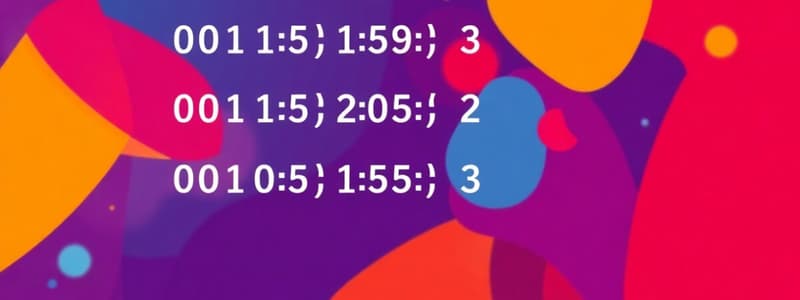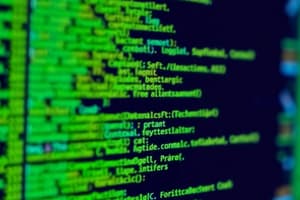Podcast
Questions and Answers
What is the primary purpose of control structures in programming?
What is the primary purpose of control structures in programming?
- To define data types
- To execute code blocks based on conditions (correct)
- To create reusable functions
- To optimize algorithms
Which type of data structure is an array?
Which type of data structure is an array?
- Primitive data type
- Composite data type (correct)
- Logical operator
- Control structure
Which of the following best defines pseudocode?
Which of the following best defines pseudocode?
- A high-level description of an algorithm (correct)
- A set of executable functions
- Code written in a specific programming language
- A visual diagram depicting the algorithm's flow
What does the term 'efficiency' in algorithm design primarily refer to?
What does the term 'efficiency' in algorithm design primarily refer to?
Which programming paradigm emphasizes encapsulating data and behaviors in objects?
Which programming paradigm emphasizes encapsulating data and behaviors in objects?
What is the role of a 'try/catch' block in programming?
What is the role of a 'try/catch' block in programming?
Which practice improves code readability?
Which practice improves code readability?
What is the main goal of testing and validation in software development?
What is the main goal of testing and validation in software development?
Flashcards are hidden until you start studying
Study Notes
Definition of Programming Logic
- Programming logic refers to the principles and structures used to design and implement algorithms.
- It underpins the process of reasoning about code and problem-solving in programming.
Key Concepts
-
Control Structures
- Conditional Statements: Execute different code blocks based on conditions (e.g.,
if,else,switch). - Loops: Repeat code blocks (e.g.,
for,while,do-while).
- Conditional Statements: Execute different code blocks based on conditions (e.g.,
-
Data Types and Variables
- Primitive data types (e.g., integers, floats, booleans).
- Composite data types (e.g., arrays, objects, lists).
-
Logical Operators
- Used to form logical expressions (e.g., AND, OR, NOT).
- Essential for conditions in control structures.
-
Functions and Procedures
- Reusable blocks of code that perform specific tasks.
- Can accept parameters and return values.
-
Algorithm Design
- Step-by-step procedure for solving a problem.
- Important concepts include:
- Efficiency: Time complexity and space complexity.
- Correctness: Ensuring the algorithm produces the desired outcome.
-
Flowcharts and Pseudocode
- Flowcharts visually represent the flow of control in algorithms.
- Pseudocode provides a high-level description of algorithms without specific syntax.
Best Practices
- Code Readability: Use meaningful variable names and comments.
- Modular Programming: Break down tasks into functions or modules for easier management.
- Debugging: Employ systematic methods to identify and fix errors in code.
Common Programming Paradigms
- Procedural Programming: Focuses on procedures or routines.
- Object-Oriented Programming (OOP): Encapsulates data and behaviors in objects (e.g., classes, inheritance).
- Functional Programming: Treats computation as the evaluation of mathematical functions.
Error Handling
- Implement techniques to manage runtime errors and exceptions gracefully.
- Use try/catch blocks and error checking to enhance program stability.
Testing and Validation
- Ensure correctness through unit testing, integration testing, and system testing.
- Validation checks input and output to prevent unexpected behavior.
Conclusion
- Understanding programming logic is fundamental for developing efficient and maintainable software.
- It lays the groundwork for mastering various programming languages and paradigms.
Programming Logic Definition
- The foundation of programming logic involves designing and implementing algorithms, and understanding how code functions to solve problems
Key Concepts
-
Control Structures:
-
Conditional Statements: Code blocks are executed based on specific conditions (e.g.,
if,else,switch) -
Loops: Code blocks are executed repeatedly (e.g.,
for,while,do-while) -
Data Types and Variables
-
Primitive: Include basic data types like integers, floats, and booleans
-
Composite: More complex data types such as arrays, objects, and lists
-
Logical Operators:
-
Used to build logical expressions involving AND, OR, and NOT operations.
-
These operators are essential for making decisions within control structures.
-
Functions and Procedures
-
Reusable blocks of code that perform specific tasks. They can receive input (parameters) and produce output (return values).
-
Algorithm Design
-
A step-by-step method for solving a problem.
-
Key considerations include:
- Efficiency: Analyzing how long the algorithm takes (time complexity) and the amount of memory used (space complexity)
- Correctness: Ensuring the algorithm produces the expected outcome
-
Flowcharts and Pseudocode
-
Flowcharts provide a visual representation of how algorithms flow through instructions.
-
Pseudocode, a high-level description of an algorithm, uses simplified language to represent the steps without specific syntax.
Best Practices
- Code Readability: Writing clear code involves choosing meaningful variable names and adding comments to explain complex sections.
- Modular Programming: Breaking down tasks into smaller, manageable units (functions or modules) allows for easier development and debugging.
- Debugging: Systematically identify and fix errors in code.
Common Programming Paradigms
- Procedural Programming: Programs are structured around procedures or routines.
- Object-Oriented Programming (OOP): The code is organized by objects, which encapsulate data and behavior (e.g., classes, inheritance).
- Functional Programming: Computation is viewed as the evaluation of mathematical functions.
Error Handling
- Implement strategies to handle potential runtime errors and exceptions gracefully.
- Techniques include
try/catchblocks and error checking for program stability.
Testing and Validation
- Essential for verifying the correctness of code.
- Various types of testing are applied:
- Unit testing: Individual components are tested.
- Integration testing: Groups of components are tested together.
- System testing: The entire system is tested as a whole.
- Input and output are validated to prevent errors.
Conclusion
- Mastering programming logic is fundamental for creating software that is efficient and maintainable. It provides a strong foundation for learning different programming languages and paradigms.
Studying That Suits You
Use AI to generate personalized quizzes and flashcards to suit your learning preferences.




